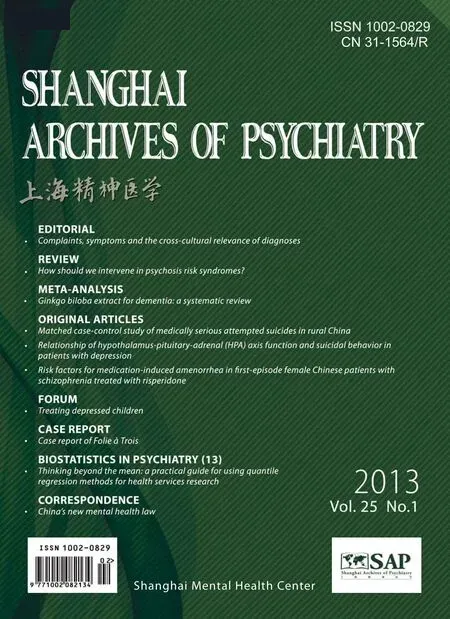Complaints, symptoms and the cross-cultural relevance of diagnoses
John E. COOPER
? Editorial ?
Complaints, symptoms and the cross-cultural relevance of diagnoses
John E. COOPER
Expensive, high-technology research currently dominates the content of most psychiatric journals,but there is still a continuing need for detailed clinical studies and for studies that address fundamental conceptual issues. These studies, which are primarily based on the interviewing and follow-up of patients and other community members, do not require expensive technology and laboratory equipment but they do need trained professional staff over significant periods of time,so they are not necessarily much cheaper than hightechnology studies. This editorial will discuss a few of these types of studies.
First, a problem of wide international interest is an as yet unanswered question: ‘When a person is interviewed about their emotional state, what is the relationship between what that person complains about and the symptoms that a psychiatrist might conclude are present?’ This question first became prominent during the Epidemiological Catchment Areas (ECA) studies in the United States[1]which involved the interview of a large sample of community members using the Diagnostic Interview Schedule (DIS).[2]This schedule was designed to be administered by specially trained lay interviewers –rather than by more expensive psychiatrists – who strictly follow the questions in the schedule about the possible presence of psychiatric symptoms and record the replies of subjects without asking follow-up questions about the frequency or severity of the reported conditions. In other words, the complaints of the subject are recorded.To compare the results of the DIS interview with a psychiatrist interested in eliciting symptoms, a sub-sample of the same subjects was re-interviewed by a psychiatrist who did not know the results of the DIS interview. The psychiatrist covered the same topics but followed the style of the Present State Examination (PSE),[3]which allows psychiatrists to ask additional questions about frequency, severity and other aspects of the subject’s state. Comparisons of the two interviews found broad similarities but some interesting differences. For many disorders, lay interviewers using the DIS obtained higher rates than psychiatrists; and, despite reporting a similar prevalence of schizophrenia (0.5% for lay interviewers and 0.7% for psychiatrists), the agreement about which individuals met the diagnostic criteria for schizophrenia was very poor (of 33 individuals given the diagnosis only 3 were assigned the diagnosis by both interviewers).[4,5]Some years later, a similar comparison was made in the United Kingdom, in which subjects were interviewed with the successors to the DIS and the PSE -- the Composite International Diagnostic Interview (CIDI)[6]administered by trained lay interviewers and the Schedule for Clinical Assessment in Neuropsychiatry (SCAN)[7]administered by psychiatrists. Again, lay interviewers using the CIDI reported higher rates of disorders than psychiatrists using the SCAN; this difference was greatest for depressive disorders and anxiety disorders.[8]
It is clear that complaints and symptoms are not the same, but nobody has yet done a follow-up study to examine which is most useful in predicting, at an individual level, such things as need for treatment, demand for treatment, response to treatment, or levels of persistent disability. Both the CIDI and the SCAN have now been used widely in different languages and cultures, so the necessary translations and modifications for a variety of languages are available. Moreover, the CIDI is the main diagnostic instrument employed in the WHO-supported World Mental Health Survey Initiative[9]that has already been conducted in 28 countries. Before basing major policy decisions on the results of these epidemiological studies, it would be important to determine the relative predictive power of complaints versus symptoms – a difference that may vary in different cultural settings.
A second unsolved clinical problem is to do with the diagnosis of neurasthenia. This diagnosis is not present in the DSM-IV, but it is included in ICD-10 because there are psychiatrists from several countries who regard it as a useful category. An opportunity to examine the symptomatic basis of neurasthenia arose during the 1982 Chinese National Epidemiological Survey, conducted in 12regions of the country.[10]The PSE-9 was used in this study,and diagnoses were made using the then current Chinese modification of ICD-9. The criteria for the diagnosis of Neurasthenia were:
A neurosis manifest principally as an unusual susceptibility to fatigue, irritability, difficulty in concentration, insomnia and a variety of unpleasant physical symptoms and feelings of weakness (asthenic feelings). Anxiety is not a prominent feature of neurasthenia (particularly anxiety symptoms related to feelings of unreality); if anxiety is prominent then a diagnosis of anxiety neurosis should be considered. In the same way, prominent depressive symptoms should usually lead to a diagnosis of depressive neurosis.(reference 10, page 32)
A detailed comparison of the symptoms of the 88 subjects given a diagnosis of neurasthenia in the national survey with subjects who had other neurotic disorders found that it was not possible to identify a unique symptom cluster that could distinguish neurasthenic patients from patients with other neurotic disorders. Despite the difficulty of distinguishing the clinical characteristics of the disorder,the diagnosis remained popular. Ten years later a large 14-country study of patients in general and primary health care settings reported the following prevalence of ICD-10 disorders in 5000 consecutive attendees:mild to moderate depression, 10.4%; neurasthenia,5.4%; somatoform disorder, 2.7%; dysthymia, 2.1%; and hypochondriasis, 0.8%.[11,12]
Perhaps it is now time to regard neurasthenia as a historical curiosity, but it would be wise to have good reasons to justify this. When writing about the history of similarly problematic but popular terms such as ‘hysteria’and ‘psychosomatic’, Aubrey Lewis[13]warned that favourite terms such as these have a tendency to outlive their obituarists. Two aspects of this problem still need investigating. First, in any particular country or culture,what proportion of psychiatrists still regard neurasthenia as a useful diagnosis, and why? (This requires a study of the psychiatrists.) Second, what are the features of patients receiving a diagnosis of neurasthenia that distinguish them from other patients in terms of symptoms and response to treatment? (This requires a study of patients.) Anybody contemplating an investigation of this problem would do well to start by consulting the reviews on neurasthenia in Problems of Psychiatry in General Practice by Gastpar and Kielholz.[14]
The study of neurasthenia is closely related to the wider topic of culture-specific disorders. Do they exist or are the clinical states covered by this term better regarded as local variants of the more generally recognised disorders such as anxiety, depression and acute stress reactions? The currently dominant classification systems such as ICD-10 and DSM-IV both contain appendices listing and describing possible culture-specific disorders,together with the suggestion that these should be investigated. But there are few published reports about these disorders, possibly because most of them are acute transient conditions that are difficult to study.
The use of the word ‘dominant’ to describe the two internationally recognized diagnostic systems is intentional. Although internationally recognised classifications are necessary as a common language for communication purposes, it is easy to forget that they come accompanied by certain dangers. The formulistic and often arbitrary definition and differentiation of diagnoses promoted by these diagnostic systems inhibit creative thinking about diagnoses and limit the examination of conditions that do not fit into the internationally accepted categories. The same can be said of structured or standardised diagnostic research interviews such as the CIDI and the SCAN. They are necessary, but what do they leave out?
Conflict of interest
The author reports no conflict of interest.
1. Robins LN, Regier DA (eds). Psychiatric Disorders in America: The Epidemiological Catchment Areas Study. New York: Free Press,1990.
2. Robins LN, Helzer JE, Croughland J, Ratcliff KS. National Institute of Mental Health Diagnostic Interview Schedule: its history,characteristics and validity. Arch Gen Psychiatry 1981; 38(4): 281-289.
3. Wing JK, Cooper JE, Sartorius N. The Measurement and Classification of Psychiatric Symptoms. Cambridge: Cambridge University Press, 1974.
4. Helzer JE, Stolzman R, Farmer A, Brockington IF, Plesons D,Singerman B, et al. Comparing the DIS with a DIS/DSM III–based physician re-evaluation. In: Eaton WW, Kessler LG(eds). Epidemiologic Field Methods in Psychiatry: the NIMH Epidemiologic Catchment Area Program. Orlando FL: Academic Press, 1985: 285-308.
5. Anthony JC, Folstein M, Romanoski AJ, Von Korff MR, Nestadt GR,Chahal R, et al. Comparison of lay Diagnostic Interview Schedule and a standardized physician diagnosis. Arch Gen Psychiatry 1985; 42(7): 667-675.
6. Robins LN, Wing J, Wittchen HU, Helzer JE, Babor TF, Burke J,et al. The Composite International Diagnostic Interview. An epidemiologic instrument suitable for use in conjunction with different diagnostic systems and in different cultures. Arch Gen Psychiatry 1988; 45(12): 1069–1077.
7. Wing JK, Babor T, Brugha T, Burke D, Cooper JE, Giel R, et al. SCAN:Schedule for Clinical Assessment in Neuropsychiatry. Arch Gen Psychiatry 1990; 47: 499-515.
8. Brugha TS, Jenkins R, Taub N, Meltzer H, Bebbington PE. A general population comparison of the Composite International Diagnostic Interview (CIDI) and the Schedules for Clinical Assessment in Neuropsychiatry (SCAN). Psychological Medicine 2001; 31: 1001-1013.
9. The World Mental Health Survey Initiative. Available at: http://www.hcp.med.harvard.edu/wmh/ (accessed 27 December 2012)
10. Cooper JE, Sartorius N. Mental Disorders in China: Results of the National Epidemiological Survey in 12 Areas. London: Gaskell,1996.
11. Ustun TB, Sartorius N (eds). Mental Illness in General Health Care:an International Study. Chichester: John Wiley and Sons, 1995.
12. Sartorius N, Ustun TB, Costa e Silva JA, Goldberg D, Lecrubier Y,Ormel J, et al. An international study of psychological problems in primary care. Arch Gen Psychiatry 1993; 50: 819-824.
13. Lewis AJ. The Survival of Hysteria. Psychological Medicine 1975;5(1): 9-12.
14. Gaspar M, Kielholtz P (eds). Problems of Psychiatry in General Practice. Toronto: Hogrefe and Huber, 1991.
10.3969/j.issn.1002-0829.2013.01.002
University of Nottingham, Nottingham, UK correspondence: johncooper@ntlworld.com

Dr. John Cooper graduated from Oxford University and then received his DPM and psychiatric post-graduate training at the Royal Bethlem and Maudsley Hospital and the Institute of Psychiatry in London. While in London, Dr. Cooper led the UK team involved in the US/UK Diagnostic Project, worked as a consulting psychiatrist at the Royal Bethlem and Maudsley Hospitals, and was the vice-dean at the Institute of Psychiatry. From 1972-1991 Dr. Cooper served as a professor and founding chair of the Department of Psychiatry at the University of Nottingham, where he is currently an emeritus professor. Dr. Cooper was a consultant to WHO in the development of the ICD-8, ICD-9, and ICD-10; he participated in the WHO Collaborative Studies on Schizophrenia; and he has been a WHO consultant to the United Arab Emirates and Saudi Arabia. Dr. Cooper’s areas of research interest include diagnostic classification, the promotion of psychiatric services in general health settings, and the measurement of disability.
- 上海精神醫(yī)學(xué)的其它文章
- How should we intervene in psychosis risk syndromes?
- Ginkgo biloba extract for dementia: a systematic review
- Relationship of hypothalamus-pituitary-adrenal (HPA) axis function and suicidal behavior in patients with depression
- Risk factors for medication-induced amenorrhea in first-episode female Chinese patients with schizophrenia treated with risperidone
- Should antidepressants be used to treat childhood depression?
- Interventions for childhood depression

